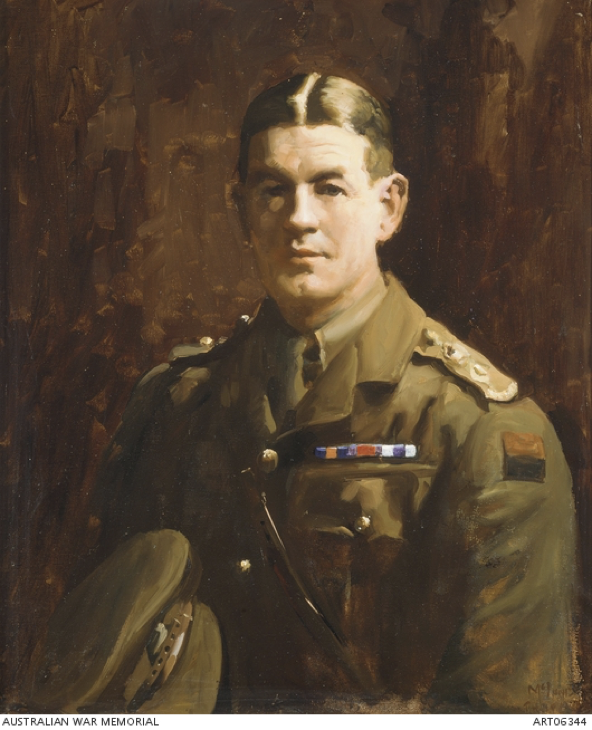Our ANZAC's
These are the stories of four local men and their comrades who fought with them against the most incredible odds. These are our ANZAC's
LT COL Terence McSharry
Warrant Officer Clifford Cecil Jones
LT Thomas Naylor and PTE Norman Watson

LT COL Terence McSharry CMG, DSO and Bar, MC
Terence McSharry was born in Rockhampton and attended Gregory Terrace after moving to Brisbane as a boy. He would become the most decorated Brisbane soldier of the First World War.
He was 30 years old, a surveyor from Clayfield when the First World War broke out.
He enlisted on the 14th of August 1914 and was appointed a Lieutenant in the 2nd Light Horse, a Queensland Regiment. He was then appointed as Intelligence Officer for the 15th Battalion, which was primarily made up of Queenslanders.
At Gallipoli, Terence McSharry first showed the extraordinary courage that would make him a great leader.
After the landing, Australian and New Zealand troops clung desperately to the ridges on the western side of the peninsula, with the might of the Turkish Army before them. Behind the Australian trenches was Shrapnel Valley and the beach, which was vital to their supplies.
Jutting into the valley like a deadly finger was a ridge, on which the foremost Australian position was known as Quinn’s Post. If the Australians lost Quinn’s, Anzac Cove would be cut in two, and our troops eventually pushed back into the sea.
It was given to the young men from Queensland to hold Quinn’s post, a narrow exposed position where the Turkish trenches were just 15 metres away, and where Turkish sniper fire was so fierce that to put one’s head above the parapet meant instant death.
The Turks also knew the importance of Quinn’s and were keen to take the Post.
In the early hours of the 28th of May 1915, they exploded a massive bomb under the centre trench. The darkened sky turned an angry red, and the Australians in the front trench were killed instantly. Hundreds of Turks came rushing forwards, throwing bombs and shooting at the Australians as they emerged from their dugouts.
At this moment, one man, Terence McSharry, would stand between survival and death for many. Seeing that the Turks were pouring into a communication trench that led to the post headquarters, McSharry sprang into action. The shattered young Australians were falling back in the face of the attack, but McSharry called out, “Come on, Australia!” and rallied the troops. He then went to the bomb store and grabbed a pile of jam tin bombs and a candle to light the fuses. Then standing exposed to the Turkish fire, he began throwing bombs at the advancing Turks. A bullet went through his hat, but he didn’t stop.
The other Australians saw him and took heart. They climbed out of the trench and began throwing their bombs as well, and the Turks were halted. Then McSharry led the Australians to the left and right to isolate the Turks, and by later that morning had recaptured the trench. Quinn’s Post had been saved and with it Anzac Cove.
McSharry's story did not end there. Awarded a Military Cross for his bravery at Gallipoli, he was sent to the Western Front, where he was eventually promoted Lt Colonel and given command of the 15th Battalion.
Among their number were local boys from Brisbane like Captain Colin Drane, Frederic Pedler, and Victor Trundle and men from across southern and central Queensland. Together they would fight and win at Pozieres and Hill 60, take terrible casualties at Bullecourt and participate in the great battle of Hamel, where Henry Dalziel won a Victoria Cross for rushing a machine gun singlehanded.
Along the way, Terence McSharry would win a Distinguished Service Order and Bar, be appointed a Companion of the Order of St Michael & St George, and be Mentioned in Dispatches many times.
Many of the men of the 15th Battalion would eventually come safely home, but not Terence McSharry. On the 6th of August, 1918, the Battalion came under German artillery fire while they were resting at Vaire on the Somme. As the shells came crashing down, McSharry saw one of his men wounded. With typical bravery, he went to help the wounded man to shelter and was himself killed.
Two days later, and inspired by his example, the men of the 15th Battalion would inflict a crushing defeat on the Germans at the Battle of Amiens, a battle which broke the German line and hastened the end of the war.
But sadly, the achievements of this great Queenslander would be largely forgotten until now. His sole legatee, his sister, died that same year, and with no family left in the district, his name was omitted from the local Honour Roll when it was erected in 1931. This error has now been corrected, and his portrait hangs proudly in the vestibule of the Clayfield-Toombul RSL.
To find out more about our Sub Branch, contact our management team by sending an email to secretary@clayfieldtoombulrsl.org or call us directly on 0419 704 164